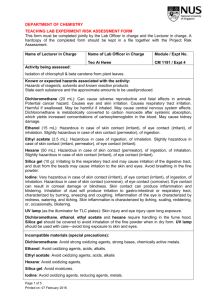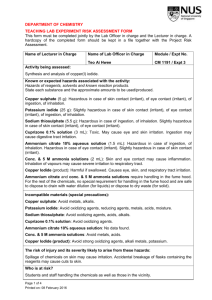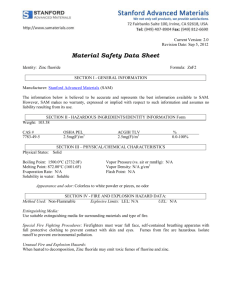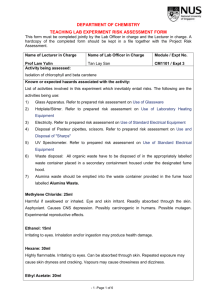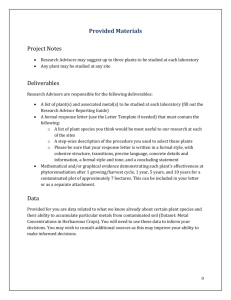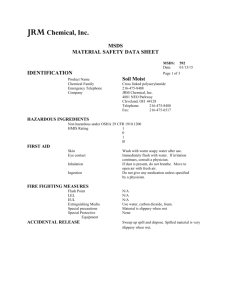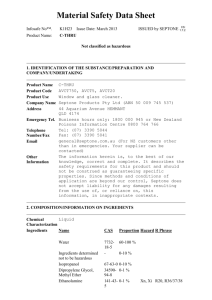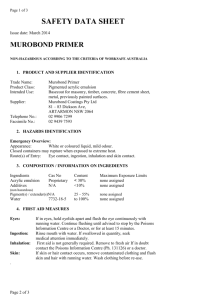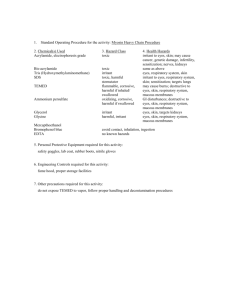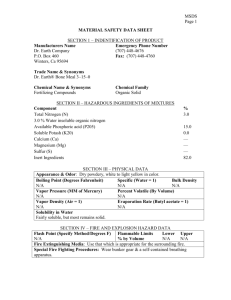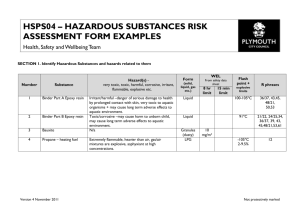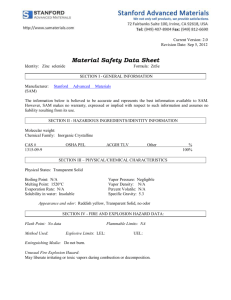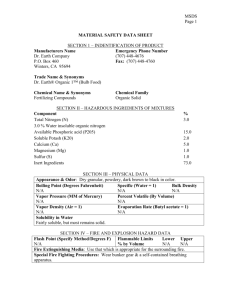DEPARTMENT OF CHEMISTRY TEACHING LAB EXPERIMENT
advertisement
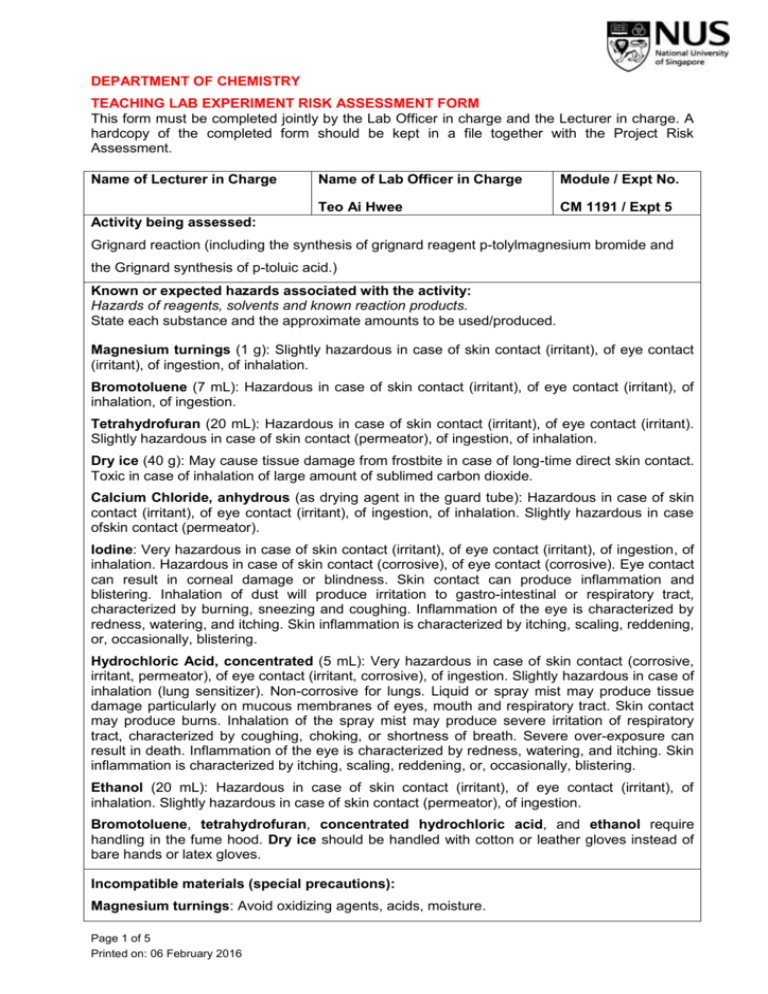
DEPARTMENT OF CHEMISTRY TEACHING LAB EXPERIMENT RISK ASSESSMENT FORM This form must be completed jointly by the Lab Officer in charge and the Lecturer in charge. A hardcopy of the completed form should be kept in a file together with the Project Risk Assessment. Name of Lecturer in Charge Name of Lab Officer in Charge Module / Expt No. Teo Ai Hwee CM 1191 / Expt 5 Activity being assessed: Grignard reaction (including the synthesis of grignard reagent p-tolylmagnesium bromide and the Grignard synthesis of p-toluic acid.) Known or expected hazards associated with the activity: Hazards of reagents, solvents and known reaction products. State each substance and the approximate amounts to be used/produced. Magnesium turnings (1 g): Slightly hazardous in case of skin contact (irritant), of eye contact (irritant), of ingestion, of inhalation. Bromotoluene (7 mL): Hazardous in case of skin contact (irritant), of eye contact (irritant), of inhalation, of ingestion. Tetrahydrofuran (20 mL): Hazardous in case of skin contact (irritant), of eye contact (irritant). Slightly hazardous in case of skin contact (permeator), of ingestion, of inhalation. Dry ice (40 g): May cause tissue damage from frostbite in case of long-time direct skin contact. Toxic in case of inhalation of large amount of sublimed carbon dioxide. Calcium Chloride, anhydrous (as drying agent in the guard tube): Hazardous in case of skin contact (irritant), of eye contact (irritant), of ingestion, of inhalation. Slightly hazardous in case ofskin contact (permeator). Iodine: Very hazardous in case of skin contact (irritant), of eye contact (irritant), of ingestion, of inhalation. Hazardous in case of skin contact (corrosive), of eye contact (corrosive). Eye contact can result in corneal damage or blindness. Skin contact can produce inflammation and blistering. Inhalation of dust will produce irritation to gastro-intestinal or respiratory tract, characterized by burning, sneezing and coughing. Inflammation of the eye is characterized by redness, watering, and itching. Skin inflammation is characterized by itching, scaling, reddening, or, occasionally, blistering. Hydrochloric Acid, concentrated (5 mL): Very hazardous in case of skin contact (corrosive, irritant, permeator), of eye contact (irritant, corrosive), of ingestion. Slightly hazardous in case of inhalation (lung sensitizer). Non-corrosive for lungs. Liquid or spray mist may produce tissue damage particularly on mucous membranes of eyes, mouth and respiratory tract. Skin contact may produce burns. Inhalation of the spray mist may produce severe irritation of respiratory tract, characterized by coughing, choking, or shortness of breath. Severe over-exposure can result in death. Inflammation of the eye is characterized by redness, watering, and itching. Skin inflammation is characterized by itching, scaling, reddening, or, occasionally, blistering. Ethanol (20 mL): Hazardous in case of skin contact (irritant), of eye contact (irritant), of inhalation. Slightly hazardous in case of skin contact (permeator), of ingestion. Bromotoluene, tetrahydrofuran, concentrated hydrochloric acid, and ethanol require handling in the fume hood. Dry ice should be handled with cotton or leather gloves instead of bare hands or latex gloves. Incompatible materials (special precautions): Magnesium turnings: Avoid oxidizing agents, acids, moisture. Page 1 of 5 Printed on: 06 February 2016 Bromotoluene: Avoid strong oxidizing agents. Tetrahydrofuran: Avoid oxidizing agents. Calcium Chloride, anhydrous: Avoid moisture. Iodine: Avoid oxidizing agents, reducing agents, metals. Hydrochloric Acid, concentrated: Avoid oxidizing agents, organic materials, metals, alkalis, moisture. Ethanol: Avoid oxidizing agents, acids, alkalis. The risk of injury and its severity likely to arise from these hazards: Spillage of chemicals on skin may cause irritation. Accidental breakage of flasks containing the reagents may cause cuts to skin. Long-time inhalation of carbon dioxide may cause headache or dizziness. Who is at risk? Students and staff handling the chemicals as well as those in the vicinity. Measure to be taken to reduce the level of risk: Wear proper PPEs. Handle bromotoluene, tetrahydrofuran, concentrated hydrochloric acid, iodine and ethanol in the fume hood. Handle dry ice with cotton gloves. Avoid skin contact with iodine. Training prerequisites: Undergraduate Safety Note Level of risk remaining: Low. Emergency action if : Spill For solid spills, use appropriate tools to put the spilled solid in a convenient waste disposal container. For liquid spills, absorb spill with inert material, then place in suitable container. Avoid runoff into sewers which lead to waterways. Clean up spills immediately. Remove all sources of ignition. Provide ventilation when dry ice is spilled. Skin contact Immediately flush skin with plenty of water while removing contaminated clothing and shoes. Wash clothing before reuse. Thoroughly clean shoes before reuse. Is the experiment suitable for out-of-hours operation? Yes No References if any: Magnesium: http://www.sciencelab.com/msds.php?msdsId=9924535 4-Bromotoluene: http://fscimage.fishersci.com/msds/34636.htm Tetrahydrofuran: http://www.sciencelab.com/msds.php?msdsId=9927294 Dry ice: http://avogadro.chem.iastate.edu/MSDS/carbon_dioxide_solid.htm Calcium chloride, Anhydrous: http://www.sciencelab.com/msds.php?msdsId=9923251 Page 2 of 5 Printed on: 06 February 2016 Hydrochloric acid: http://www.sciencelab.com/msds.php?msdsId=9924285 Ethanol: www.sciencelab.com/msds.php?msdsId=9923955 Iodine: www.sciencelab.com/msds.php?msdsId=9927547 Signature of Lab Officer in Charge:……………………………………………………………….. Date:………………………… Signature of Lecturer in Charge:………… …………………………………….. Date:… …………………….. Prepared Risks Assessments for standard equipment and operation are with the kind permission of Dr. Ken MacNeil, School of Chemistry, University of Bristol. Page 3 of 5 Printed on: 06 February 2016 Activity being assessed: Note any activity to be used which entail risk (e.g. use of glass vacuum apparatus, high pressures, high voltage, radiation, high temperatures). Give reference to any special protocols to be followed, and if appropriate attach copies to the risk assessment form. State any additional precautions taken to minimise risk. Known or expected hazards associated with the activity: FOR EACH CHEMICAL, read the MSDS and note:a) Particular hazards (e.g. highly toxic, carcinogenic, corrosive, flammable, pyrophoric, explosive, volatile, dust hazard). Note any dangerous combinations of properties (e.g. volatile and toxic). b) Requirements for safe handling (e.g. fume cupboard, inert atmosphere, low temperature). c) How to dispose of residuals Dispose to drain, with water dilution Neutralise, then to drain with suitable dilution To flammable liquid waste receptacle To non-flammable liquid waste receptacle Keep for recovery/recycling Keep for special disposal later (e.g. heavy metals) Double bag and dispose to dry waste Special procedure (specify) Incompatible materials (special precautions) Note any dangerously incompatible materials and hazards arising from contact of any reagents and substances used with common materials such as paper, benches, hoses, etc. Measures to be taken to reduce the level of risk Include hazards of previously unknown products. Location of work – laboratory, open bench, fume cupboard Level of risk remaining: Likelihood and consequences of any accident or unforeseen events whilst carrying out the activity. When this has been done, choose the appropriate procedure:a) Close supervision and/or attendance of trained first-aider needed. b) Specific approval of supervisor needed. c) Training is needed prior-to or during the operations specified. d) Training is complete and only general laboratory competence required. e) No risk perceived. Emergency action: a) Any special requirements to deal with accidental spillage or leakage. Page 4 of 5 Printed on: 06 February 2016 b) What to do in the event of accidental exposure (skin contact, inhalation, etc.). Page 5 of 5 Printed on: 06 February 2016
